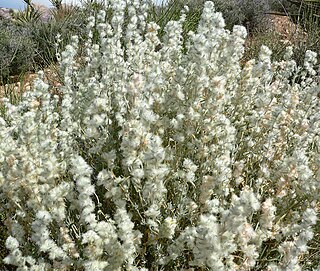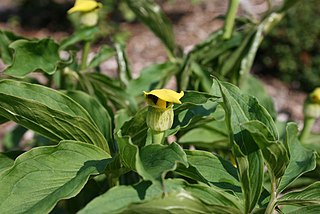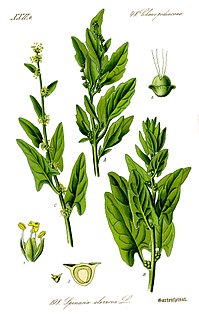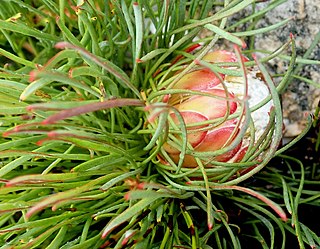
Plant reproductive morphology is the study of the physical form and structure of those parts of plants directly or indirectly concerned with sexual reproduction.

Pachypodium brevicaule is a species of plant that belongs to the family Apocynaceae.
Lilian Suzette Gibbs (1870–1925) was a British botanist who worked for the British Museum in London and an authority on mountain ecosystems.

Krascheninnikovia is a genus of flowering plants in the subfamily Chenopodioideae of the family Amaranthaceae known as winterfat, so-called because it is a nutritious livestock forage. They are known from Eurasia and western North America. These are hairy perennials or small shrubs which may be monoecious or dioecious. They bear spike inflorescences of woolly flowers.
This glossary of botanical terms is a list of definitions of terms and concepts relevant to botany and plants in general. Terms of plant morphology are included here as well as at the more specific Glossary of plant morphology and Glossary of leaf morphology. For other related terms, see Glossary of phytopathology and List of Latin and Greek words commonly used in systematic names.

Arisaema flavum is a species of flowering plant widespread across north-eastern Africa and southern Asia. It is native to Ethiopia, Somalia, the Arabian Peninsula, Pakistan, Afghanistan, Nepal, Assam, Himalayas, Tibet, Yunnan, and Sichuan. The species epithet flavum is Latin for yellow and indicates its flower colour.

Spinacia is a flowering plant genus in the subfamily Chenopodioideae of the family Amaranthaceae. The most common member is spinach.
Dodecadenia is a botanical genus of flowering plants in the family Lauraceae. It is present from central Asia, to Himalayas and India. It is present in tropical and subtropical montane rainforest, laurel forest, in the Weed-tree forests in valleys, mixed forests of coniferous and deciduous broad-leaved trees, Tsuga forests; 2,000–2,600 metres (6,600–8,500 ft) in China in provinces of Sichuan, Xizang, Yunnan, and countries of Bhutan, India, Myanmar, and Nepal.

Suaeda aegyptiaca is a species of succulent plant in the family Amaranthaceae, and salt-tolerant (halophyte) plant that is distributed in eastern North Africa, the Near East and West Asia.

Chenopodiastrum is a genus of herbaceous flowering plants in the family Amaranthaceae. The genus was formally described in 2012. The 5 species occur in Eurasia, North Africa, and North America.

Stutzia is a plant genus in the subfamily Chenopodioideae of the family Amaranthaceae. It was described in 2010, replacing the illegitimate name Endolepis. It comprises two species, that have also been included in the genus Atriplex.
Proatriplex is a monotypic plant genus in the subfamily Chenopodioideae of the family Amaranthaceae, with the only species Proatriplex pleiantha. It is known by the common names Four-corners orach and Mancos shadscale. It occurs in the Navajo Basin of Arizona, Colorado, New Mexico, and Utah.

Berberidopsis beckleri is a species of climbing plant found in cool rainforests in eastern Australia. It's common name is the montane tape vine. Ferdinand von Mueller described the plant as Streptothamnus beckleri from collections at the Clarence River.

Mimetes stokoei, the mace pagoda, is an evergreen, upright, hardly branching, large shrub of 1–2 m high in the family Proteaceae. It has silvery, oval leaves of 5–8 cm (2.0–3.2 in) long and 2+1⁄2–4 cm (1.0–1.6 in) wide, with one large tooth supported by two smaller teeth near the tip, at an upward angle and somewhat overlapping each other. The inflorescences are set just below the growing tip, are cylinder-shaped, 10–12 cm (4–5 in) high, topped by a crest of small, more or less horizontal, pinkish-purple tinged leaves. It consists of several flower heads in the axils of golden leaves with a pinkish wash that form a hood shielding the underlying flower head. Each flower head contains eight to twelve individual flowers, with amber-colored styles topped by blackish purple pollen presenters and grey silky perianth lobes. It is endemic to the Fynbos ecoregion of South Africa, being confined to the Kogelberg mountain range. The mace pagoda was twice presumed extinct, but reappeared in its natural habitat from seed, after a wildfire several decades later.

Protea pendula, also known as the nodding sugarbush or arid sugarbush, is a flowering plant of the genus Protea, in the family Proteaceae, which is only found growing in the wild in the Cape Region of South Africa. In the Afrikaans language it is known as knikkopsuikerbossie or ondersteboknopprotea.

Protea sulphurea, also known as the sulphur sugarbush, is a flowering plant of the genus Protea in the family Proteaceae, which is only known to grow in the wild in the Western Cape province of South Africa. A vernacular name for the plant in the Afrikaans language is heuningkoeksuikerbos or Skaamblom.

Protea montana also known as the Swartberg sugarbush, is a flowering plant of the genus Protea within the family Proteaceae, which is endemic to the southwestern Cape Region of South Africa. In Afrikaans it is known as swartbergsuikerbos.
Protea decurrens, also known as linear-leaf sugarbush, is a shrub of the genus Protea, in the Proteaceae family, which is endemic to the southwestern Cape Region of South Africa. It is a small shrub with a thick underground rootstock, this structure throwing up numerous leafy branches, upon the base of which clusters of flower heads may appear close to the ground. It is pollinated by rodents and grows in low-altitude fynbos or renosterveld.
Salix alatavica is a small shrub from the genus of willow (Salix). It is native to mountainous slopes in Asia, in Kazakhstan, southern Russia, Mongolia, and northern China.

Dais is a genus of flowering plants in the family Thymelaeaceae. It is also part of the Gnidia subfamily, along with Gnidia, Drapetes, Kelleria, Pimelea, Struthiola, Lachnaea and Passerina, other genra of species). It is distributed between Tanzania to S. Africa, Madagascar. It is native to the countries of Lesotho, Madagascar, Malawi, Swaziland, Tanzania, Zimbabwe and it is also found within several Provinces of South Africa, such as Cape Provinces, Free State, KwaZulu-Natal and Northern Provinces.













